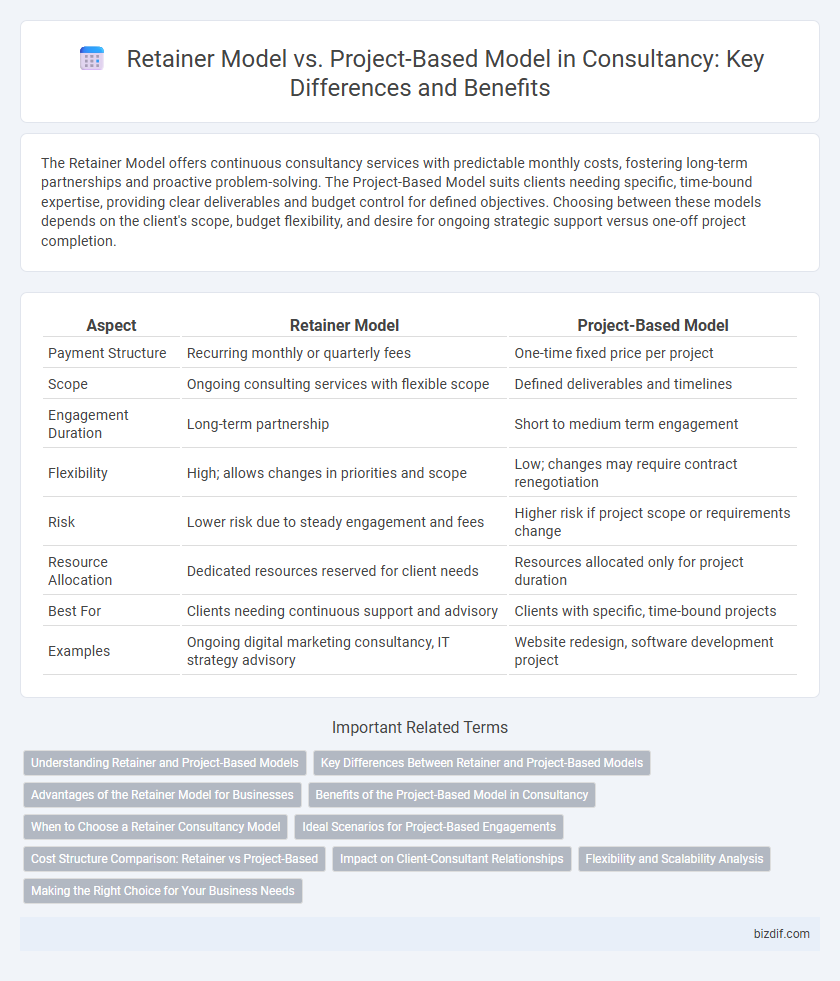The Retainer Model offers continuous consultancy services with predictable monthly costs, fostering long-term partnerships and proactive problem-solving. The Project-Based Model suits clients needing specific, time-bound expertise, providing clear deliverables and budget control for defined objectives. Choosing between these models depends on the client's scope, budget flexibility, and desire for ongoing strategic support versus one-off project completion.
Table of Comparison
| Aspect | Retainer Model | Project-Based Model |
|---|---|---|
| Payment Structure | Recurring monthly or quarterly fees | One-time fixed price per project |
| Scope | Ongoing consulting services with flexible scope | Defined deliverables and timelines |
| Engagement Duration | Long-term partnership | Short to medium term engagement |
| Flexibility | High; allows changes in priorities and scope | Low; changes may require contract renegotiation |
| Risk | Lower risk due to steady engagement and fees | Higher risk if project scope or requirements change |
| Resource Allocation | Dedicated resources reserved for client needs | Resources allocated only for project duration |
| Best For | Clients needing continuous support and advisory | Clients with specific, time-bound projects |
| Examples | Ongoing digital marketing consultancy, IT strategy advisory | Website redesign, software development project |
Understanding Retainer and Project-Based Models
Retainer models in consultancy involve ongoing access to expert services for a fixed monthly fee, ensuring consistent support and strategic guidance. Project-based models focus on delivering specific outcomes within a defined scope and timeline, with payments tied to project milestones or completion. Selecting between retainer and project-based models depends on business needs, budget flexibility, and the desired level of consultant engagement.
Key Differences Between Retainer and Project-Based Models
The retainer model involves ongoing consultancy services with a fixed monthly fee, ensuring continuous support and strategic advice, while the project-based model is limited to specific deliverables within a defined timeframe and budget. Retainer agreements offer predictable revenue and stronger client relationships, whereas project-based contracts focus on short-term objectives and clear scope boundaries. The choice between models impacts resource allocation, billing structure, and client engagement strategies in consultancy firms.
Advantages of the Retainer Model for Businesses
The Retainer Model offers businesses consistent access to consultancy expertise, ensuring ongoing strategic support and faster response times compared to the Project-Based Model. This approach facilitates long-term relationship building, enabling consultants to deeply understand business goals and tailor solutions effectively. Predictable budgeting and resource allocation under the Retainer Model also enhance financial planning and operational efficiency for companies.
Benefits of the Project-Based Model in Consultancy
The project-based model in consultancy offers clear deliverables and defined timelines, enabling clients to budget effectively and measure success against specific goals. It fosters focused expertise by aligning consultants with specialized tasks, which enhances efficiency and outcome quality. This model also provides flexibility, allowing clients to engage consultants on distinct projects without long-term commitments or resource allocation.
When to Choose a Retainer Consultancy Model
Choosing a retainer consultancy model is ideal when clients require ongoing strategic support and continuous access to expert advice over an extended period. This model ensures predictable costs, fosters long-term collaboration, and allows consultants to proactively address evolving business challenges. Organizations with dynamic needs or those seeking sustained growth benefit most from the flexibility and stability of a retainer agreement.
Ideal Scenarios for Project-Based Engagements
Project-based consultancy models are ideal for well-defined, short-term initiatives with specific deliverables and timelines, such as product launches or technology implementations. Companies seeking measurable outcomes and clear budget allocations benefit from this approach, ensuring accountability and focused resource allocation. Organizations undergoing discrete transformations or tactical problem-solving often prefer project-based engagements for their flexibility and clarity.
Cost Structure Comparison: Retainer vs Project-Based
The retainer model offers predictable, consistent monthly fees that facilitate steady cash flow and long-term budget planning, often covering ongoing consultancy services with flexible deliverables. In contrast, the project-based model involves variable costs tied to specific deliverables or milestones, resulting in potential cost fluctuations and less predictable expenses. Choosing between these models requires evaluating business needs, cash flow stability, and the scope of consultancy services to optimize cost efficiency.
Impact on Client-Consultant Relationships
The retainer model fosters ongoing collaboration and trust by ensuring continuous access to consultancy expertise, leading to deeper client-consultant relationships and proactive problem-solving. In contrast, the project-based model typically emphasizes short-term deliverables, which may limit relationship depth and reduce opportunities for strategic alignment. Long-term engagement under a retainer often results in better understanding of client needs and enhanced value delivery.
Flexibility and Scalability Analysis
The Retainer Model offers enhanced flexibility by allowing ongoing access to consultancy services, enabling businesses to adjust priorities and scope dynamically without renegotiating contracts. In contrast, the Project-Based Model provides limited scalability, as each initiative requires distinct agreements and fixed deliverables, which can constrain rapid response to evolving business needs. Scalability in the Retainer Model supports continuous strategic alignment, whereas the Project-Based Model suits isolated, well-defined projects with clear timelines.
Making the Right Choice for Your Business Needs
Choosing between a retainer model and a project-based model requires evaluating your business's long-term goals and cash flow stability. The retainer model offers consistent support and predictable budgeting by providing ongoing consultancy services, ideal for businesses needing continuous expertise. In contrast, the project-based model suits companies with specific, short-term objectives seeking flexibility and clear deliverables without extended commitments.
Retainer Model vs Project-Based Model Infographic

 bizdif.com
bizdif.com